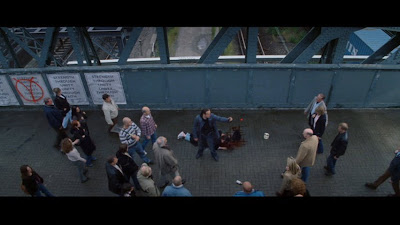 The first shot is that of mixture, between medium and long shots. The characters wings are spread out as if to establish his own presence, and his posture are a dead giveaway of what’s going on. He’s being backed into a corner and now he’s standing up for himself.
The first shot is that of mixture, between medium and long shots. The characters wings are spread out as if to establish his own presence, and his posture are a dead giveaway of what’s going on. He’s being backed into a corner and now he’s standing up for himself. The second shot is that of a picturesque view of what looks to be an angel about to spread his wings.
The second shot is that of a picturesque view of what looks to be an angel about to spread his wings.
 This last shot is a composite of two different shot techniques: A long shot, and a subjective point of view, and that is why I found this shot interesting.
This last shot is a composite of two different shot techniques: A long shot, and a subjective point of view, and that is why I found this shot interesting.














































